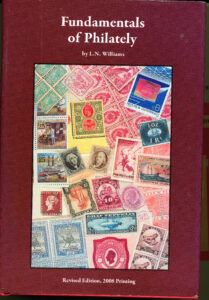 Serious collectors have long been told that the great introductory book that they need to read is L N Williams “Fundamentals of Philately”. The book was first serialized in the 1950’s in the American Philatelic Society’s magazine The American Philatelist, and has been reprinted several times, most recently in 2008 as an 825 page tome. Serious philatelists have always paid homage to this book as the fount of collecting wisdom, though I’m not sure how many of them ever read it. The reason, I can now report, after several serious attempts to make it through it again (I thought there was something wrong with me when I hated the experience of reading it forty years ago) is that “Fundamentals of Philately” is fundamentally unreadable. And even if you were to read it all, which I did, the book is very unlikely to improve you collecting experience.
Serious collectors have long been told that the great introductory book that they need to read is L N Williams “Fundamentals of Philately”. The book was first serialized in the 1950’s in the American Philatelic Society’s magazine The American Philatelist, and has been reprinted several times, most recently in 2008 as an 825 page tome. Serious philatelists have always paid homage to this book as the fount of collecting wisdom, though I’m not sure how many of them ever read it. The reason, I can now report, after several serious attempts to make it through it again (I thought there was something wrong with me when I hated the experience of reading it forty years ago) is that “Fundamentals of Philately” is fundamentally unreadable. And even if you were to read it all, which I did, the book is very unlikely to improve you collecting experience.
When I was growing up in the hobby in the 1960’s, serious collectors worshipped at the altar of “Fundamentals”. This was part of the trend that was so prevalent in the previous generation of collectors to over intellectualize our hobby. Over intellectualization can be the result of many causes, but, in philately, I think it stems from a somewhat sneaking suspicion that what we most enjoy about collecting stamps is just pure pleasure-the joy of acquisition, and creating order out of disorder. This pleasure is quite visceral and shared by those collectors, who seem to most love their hobby. But it is a feeling that exists in the soft and fuzzy world of pleasures, not the intellect. And if there was anything the previous generations of philatelists wanted to do, it was to establish stamp collecting as a serious academic discipline. There is a harsh bent in some collectors, who seem to need to make very simple joys into a lot of hard work.
So we got 825 page books like “Fundamentals of Philately’ with 65 pages on watermarks and paper, and 85 pages on” Planographic Printing” (and I still don’t understand what it is) whose first sentence begins “Planographic printing is limited to the mechanical transference to paper in lithographic printing ink from a printing base with a substantially uniform surface, of a design placed there by a combination of manual, mechanical or photographic and chemical compounds.” Still awake? You’d be startled to know just how unimportant this complex printing method was for making stamps. Williams probably spent more pages -85- describing it, than there are differing stamps that were printed by this awkward and primitive method.
There are many classics books in many fields that are often discussed and revered by people in the field, many of whom clearly have never read them. I wonder how many psychologists have read “The Interpretation of Dreams” or how many biologists “The Origin of Species” (and those two books have the advantage over “Fundamentals of Philately’ of being exceeding well written by two masters of nonfiction prose). In the end Fundamentals of Philately has little meaning for today’s generation of collectors, not just because it’s boring and turgid. It’s also because so much detail detracts from the very experience that it was intended to enhance.
One doesn’t need to know about fusion and gas dynamics to enjoy a sunset. Stamp collectors who don’t over complicate what can be a very enjoyable hobby are the one who seem to get the most out of philately.
